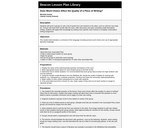
This article details the key qualities of strong writing.
- Subject:
- English Language Arts
- Material Type:
- Student Guide
- Provider:
- Education Northwest
- Author:
- Education Northwest
- Date Added:
- 04/23/2019

This article details the key qualities of strong writing.

This resource accompanies our Rethink 8th Grade ELA course. It includes ideas for use, ways to support exceptional children, ways to extend learning, digital resources and tools, tips for supporting English Language Learners and students with visual and hearing impairments. There are also ideas for offline learning.

This parent guide supports parents in helping their child at home with the 8th grade ELA content.

Using newspapers or magazines, students will create an acrostic poem where words are divided into parts of speech.

Students will complete a close reading of Ted Kooser’s poem, Abandoned Farmhouse. Students will use their knowledge about the Great Depression and the Dust Bowl to determine the setting and characters in the poem. After analyzing the author’s style, use of figurative language, and structure of the poem, students will write an ORIGINAL POEM in the spirit of Abandoned Farmhouse by using the same syntax. Using the original poem and a template as a guide, students will compose a poem that reveals who they are through the voice of important objects in their homes.

In this lesson, students will consider the strategies Ida B. Wells deployed to raise awareness of social problems and weigh the effectiveness of nonconformity to address a specific audience. Students will use Wells' story to write about a personal experience of conformity or non-conformity.

In this lesson, students will understand excerpts from an autobiographical work and retell scenes from the book. They will also collaborate to convert segments of the text into dialogue, creating a brief play about Susie King Taylor's involvement in the Civil War.

In this lesson, students write a biographical poem about themselves using an easy formula.

In this lesson, students will learn about brainstorming and how to effectively use this prewriting tool for four different writing tasks - persuasive writing, expository writing, character development, and the development of vivid and precise details for any subject.

In this lesson, students will select a piece of their own writing that contains dialogue then go through the piece highlighting the speech of each character in a different color. Then they will go through the piece again looking for and correcting "character clashes" that occur when two speakers are highlighted in the same paragraph.

Students will develop characters as part of a narrative involving creatures that reside in a student's imagination.

This lesson uses creatures created from students' imaginations to teach hyperbole, simile, metaphor, and alliteration in association with creative writing.

In this lesson, students practice writing descriptive essays.

This resource contains a large number of creative writing prompts to encourage the flow of ideas.

In this lesson, students use primary source documents to research Lincoln's life. Students will then write a journal entry as Abraham Lincoln.

In this lesson students will work in groups to rank a list of words from one extreme to the other, such as cold-hot, love-hate, etc. Groups will share their results with the class. After discussion and upon reviewing model descriptive writing, students will apply their knowledge by making more specific word choices to complete a descriptive writing assignment.

Students will read the story, Tar Beach by Faith Ringgold and compare thier own lives with that of a girl in a tenement builidng in New York City. Through reading the story, students will better understand the hopes and dreams of the less fortunate.
Student will predict ideas or events that may take place in the text, give rationale for predictions, confirm and discuss predictions as the story progresses.

Students will write their own poems and publish them using Book Creator. Students will first choose a book about a topic they have studied in other classes (math, science, social studies, encore) and use this book to gather key events and ideas to write their poem.

As a way to support teachers with English Language Arts (ELA) instruction during the pandemic, the NCDPI ELA team created choice boards featuring standards-aligned ELA activities.The intended purpose of these choice boards is to provide a way for students to continue standards-based learning while schools are closed. Each activity can be adapted and modified to be completed with or without the use of digital tools. Many activities can also be repeated with different texts. These standards-based activities are meant to be a low-stress approach to reinforcing and enriching the skills learned during the 2019-2020 school year. The choice boards are to be used flexibly by teachers, parents, and students in order to meet the unique needs of each learner.Exploration activities are provided for a more self-directed or guided approach to independent learning for students. These activities and sites should be used as a way to explore concepts, topics, skills, and social and emotional competencies that interest the learner.

This lesson guides students through the five-paragraph essay format.